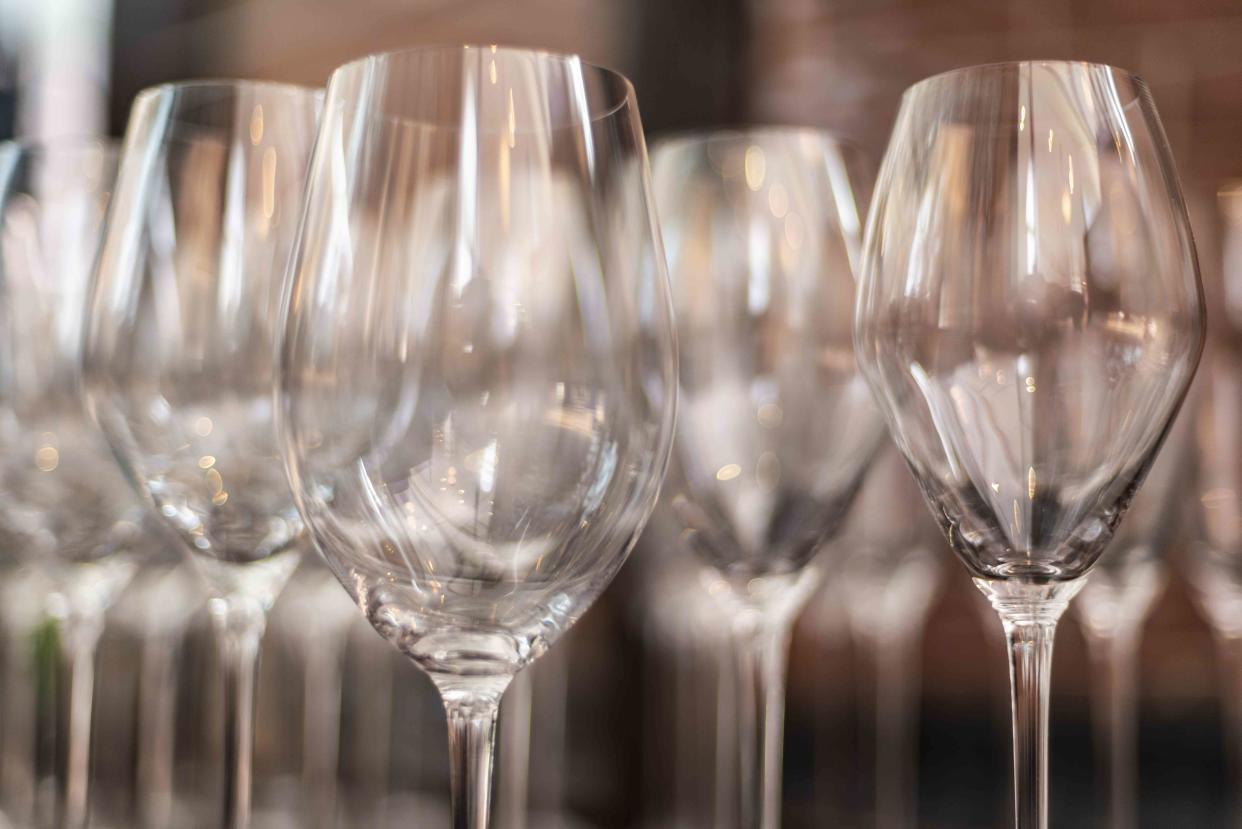How To Avoid Water Spots On Wine Glasses, According To The Pros
Learn how to clean wine glasses without leaving spots or streaks with these tips from sommeliers, winemakers, wine shop owners, and other vino experts.

Getty Images
When setting the table for a dinner party or a special meal with a partner or friend, streaky and speckled wine glasses can wreak immediate havoc on the mood. Washing glasses in a way that keeps them clear and sparkling takes a bit of know-how, so we consulted a group of sommeliers, winemakers, wine shop owners, and other vino experts to get their best advice for banishing wine glass water spots forever.
Hand-Wash Wine Glasses
The safest and most easily available cleaning option for most wine glass owners is to “wash by hand with very hot water and mild soap,” says Darrin Ylisto, co-owner of natural wine shop Really Really Nice Wines in New Orleans, Louisiana.
While our experts acknowledge that most restaurants and bars wash their wine glasses with machines, they pointed out that the average at-home wine drinker doesn’t have a commercial-grade glasswasher in their kitchen. Restaurants use these specially-designed washers for glassware-only cycles (which reduces the chance of residue landing and lingering inside the wine glass bowls), and commercial glasswashers don’t use a drying cycle. “Home dishwashers often have a ‘dry’ cycle, and we do not recommend putting glassware in the dishwasher if your model has a non-optional drying cycle. If you can opt out of a drying cycle, you can put your glassware in the dishwasher,” says Ylisto.
When it comes to the soap to use at home, James Sparks, owner/winemaker Kings Carey Wines in Santa Barbara, California, tells us that “it's always preferable to use an unscented dish soap so the scent does not linger on or in the glassware.”
After you wash the glass with soap and a soft sponge or scrub brush, “rinse, rinse, rinse—you want to see the complete absence of soap bubbles and the water should run clear,” says Ylisto.“
Use a Microfiber Cloth to Polish
Hand-washing or machine washing may get your glasses clean, but to make them really shine, you’ll need to polish them, a task that’s a staple of restaurant “side work.” The first crucial step involves acquiring the right type of polishing cloth. “The type of cloth used tends to make a big difference. People often use materials that leave debris on the glass, making it necessary to perform double the work to make them suitable for proper wine service,” explains Anthony Schlotzhauer, sommelier of BOA Steakhouse In Austin, Texas.
Instead, “whether washing by hand or via your dishwasher, immediately dry the glass while it is wet with a dry microfiber cleaning cloth for glass. A clean microfiber cloth is made of lint-free material and is integral for streak-free polishing,” says Amy Yancey, wine director and sommelier of Urban Wren in Greenville, South Carolina. To prevent your fingertips from making contact with the glass or with the microfiber cloth, Ericka Predmore, beverage director of Uptown Sports Club in Austin, Texas, urges you to “wear gloves to keep your microfiber free of oils from your skin.”
Polish Quickly When Damp
For best results, polishing should happen when your glassware is “still warm and slightly damp” from washing, says Ylisto. If you’re using a dishwasher, ”remove one glass at a time for polishing and close the dishwasher door every time you remove a glass. That way, the glasses stay in a steamy environment and don't dry. If you've washed by hand, the glasses will likely stay damp-ish for a while.”
Our experts all agree that polishing a glass after it fully dries will inevitably leave streaks, so you want to act quickly while the glass is still warm and damp. But if you do accidentally let your clean glass dry before polishing, “heat up some water to create some steam, carefully hold those glasses over to fog up, then polish away,” says Mark Sayre, beverage director of Goodnight Hospitality in Houston, Texas. To add an extra level of shine, “you can also put some high-proof alcohol diluted with water in a spray bottle, then spray a very light spritz on the wine glass before polishing with a microfiber cloth,” Courtney Kaplan, owner and wine + sake Director of Camélia, OTOTO, and Tsubaki in Los Angeles, California, tells us.
Don’t Air Dry.
If there’s any residual dampness on the glass after polishing, resist the urge to let it air dry. “Do not turn glassware upside-down on a non-porous surface. This creates a cloudy residue in the bowl. It can be washed away, but I've seen glassware remain somewhat cloudy even after washes,” Ylisto says.
“Allowing glasses to air dry can lead to hard water spots and streaks that are difficult to remove,” warns Art DeCaro, director of training at Waters Edge Wineries. “It’s best to dry them immediately with a towel.”
For more Southern Living news, make sure to sign up for our newsletter!
Read the original article on Southern Living.
